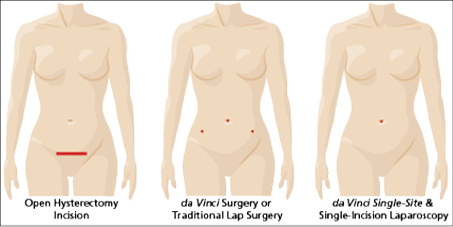da Vinci® Hysterectomy Brochure
da Vinci® Benign Hysterectomy
Your Doctor may recommend a hysterectomy if you’re facing benign (non-cancerous) gynecologic conditions. Common types of conditions are: fibroids, adenomyosis, endometriosis, heavy menstrual bleeding or pelvic prolapse. One of the best approaches to remove the uterus, include minimal invasive da Vinci®Surgery.
Why da Vinci Surgery?
With the da Vinci System, surgeons can operate through just a few small incisions, which also contains a 3D high definition magnified vision system. The da Vinci system achieves surgery with miniature wristed instraments that rotate to a greater degree than the human wrist. As a result, da Vinci allows your surgeon to operate with enhanced sight, accuracy and control.
da Vinci Hysterectomy is the #1 minimally invasive hysterectomy performed in the U.S.1
DaVinci Hysterectomy Benefits
As a result of da Vinci technology, potential benefits of da Vinci Hysterectomy compared to open surgery include:
- Less blood loss2
- Fewer complications2
- Shorter hospital stay2
- Small incisions for minimal scarring2
Potential benefits of da Vinci Hysterectomy compared to traditional laparoscopy include:
- Less blood loss3
- Lower conversion rate to open surgery3
- Shorter hospital stay3,4
- Less need for narcotic pain medicine5,6
Single-Site Hysterectomy offers the following potential benefits:
- Low blood loss7
- Low rate of converting to traditional laparoscopy and open surgery7
- Low rate of complications7
- Short hospital stay7
- Small incision for virtually scarless results7
Robotic Hysterectomy
State-of-the-art da Vinci uses the most modern surgical and robotic techniques for simple and complex procedures. Your doctor controls the da Vinci System, which exchanges their hand movements into smaller, more accurate movements of small instruments inside your body. Without your surgeon the system will not work.
The da Vinci System has brought minimally invasive surgery with less pain, less blood loss, less scaring, and shorter recovery along with many more benefits. Patients can now experience surgery in a completely different way with the da Vinci system.
RISKS & CONSIDERATIONS RELATED TO HYSTERECTOMY (BENIGN, NON-CANCEROUS) & DA VINCI SURGERY
Injury to the ureters (ureters drain urine from the kidney into the bladder), vaginal cuff problem (replaces cervix): scar tissue in vaginal incision, infection, bacterial skin infection, pooling/clotting of blood, incision opens or separates, injury to bladder (organ that holds urine), bowel injury, vaginal shortening, problems urinating (cannot empty bladder, urgent or frequent need to urinate, leaking urine, slow or weak stream), abnormal hole from the vagina into the urinary tract or rectum, vaginal tear or deep cut. Patients undergoing a hysterectomy who have an undiagnosed cancer may be at risk of having cancer cells spread if the uterus is cut into pieces for removal.
*da Vinci® Single-Site® is available for benign (non-cancerous) hysterectomy.
Contact Us About Our Gynecologic Services
At Pavilion Healthcare and Wellness Center, we are devoted to providing a full range of gynecology services. For that reason, we provide Da Vinci Surgery. If you would like more information on the services we provide, please call us at (786) 615-6123 or click here for an appointment.
PN 1002184 Rev B 06/2014
- Inpatient data: Agency for Healthcare, Research and Quality (AHRQ). Outpatient data: Solucient® Database – Truven Health Analytics. da Vinci data: Intuitive Surgical internal estimates.
- Landeen L, Bell M, Hubert H, Seshadri-Kreaden U, Hassebroek J. A Comparative Study of Four Surgical Approaches for Hysterectomy at a Single Institution: Outcomes and Costs of Robot-Assisted, Laparoscopic, Vaginal, and Abdominal Procedures. Pending publication June 2011, South Dakota Medical Review.
- Payne T. N. and F. R. Dauterive. A comparison of total laparoscopic hysterectomy to robotically assisted hysterectomy: surgical outcomes in a community practice. (In this study, surgeons treated patients with benign conditions that included endometriosis resection.) J Minim Invasive Gynecol, 2008;15(3): 286-291.
- Giep BN, Giep HN, Hubert HB. Comparison of minimally invasive surgical approaches for hysterectomy at a community hospital: robotic-assisted laparoscopic hysterectomy, laparoscopic-assisted vaginal hysterectomy and laparoscopic supracervical hysterectomy. J Robot Surg. 2010 Sep;4(3):167-175. Epub 2010 Aug 10.
- Shashoua AR, Gill D, Locher SR. Robotic-assisted total laparoscopic hysterectomy versus conventional total laparoscopic hysterectomy. JSLS. 2009 Jul-Sep;13(3):364-9.
- Betcher R MD, Chaney P MD, Otey S MD, Wood D DO, Lacy P MD, Lee M RN, Chi G PhD. A Retrospective Analysis of Post Operative Pain in Patients Following da Vinci Robotic Hysterectomy and Total Laparoscopic Hysterectomy. Oral presentation, Presented at: AAGL 2012.
- Cela V, Freschi L, Simi G, Ruggiero M, Tana R, Pluchino N. Robotic single-site hysterectomy: feasibility, learning curve and surgical outcome. Surg Endosc. 2013 Jul;27(7):2638-43. doi: 10.1007/s00464-012-2780-8. Epub 2013 Feb.
Serious complications may occur in any surgery, including da Vinci® Surgery, up to and including death. Examples of serious or life-threatening complications, which may require prolonged and/or unexpected hospitalization and/or reoperation, include but are not limited to, one or more of the following: injury to tissues/organs, bleeding, infection and internal scarring that can cause long-lasting dysfunction/pain. Risks of surgery also include the potential for equipment failure and/or human error. Individual surgical results may vary.
Risks specific to minimally invasive surgery, including da Vinci Surgery, include but are not limited to, one or more of the following: temporary pain/nerve injury associated with positioning; temporary pain/discomfort from the use of air or gas in the procedure; a longer operation and time under anesthesia and conversion to another surgical technique. If your doctor needs to convert the surgery to another surgical technique, this could result in a longer operative time, additional time under anesthesia, additional or larger incisions and/or increased complications.
Patients who are not candidates for non-robotic minimally invasive surgery are also not candidates for da VinciSurgery. Patients should talk to their doctor to decide if da Vinci Surgery is right for them. Patients and doctors should review all available information on non-surgical and surgical options in order to make an informed decision. For Important Safety Information, including surgical risks, indications, and considerations and contraindications for use, please also refer to www.davincisurgery.com/safety and www.intuitivesurgical.com/safety. Unless otherwise noted, all people depicted are models.





